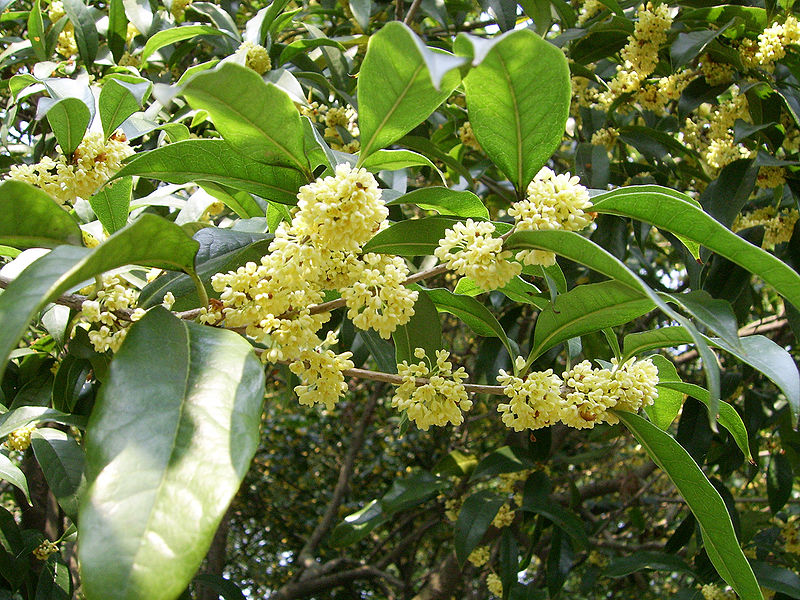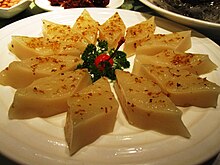桂花(学名:Osmanthus fragrans),又名木樨、梫、月桂,常绿灌木或小乔木;叶子对生,多呈椭圆或长椭圆形,叶面光滑,革质,叶边缘有锯齿;秋季开花,花簇生于叶腋,花冠分裂至基乳有乳白、黄、橙红等色,极芳香;核果成熟后为紫黑色。常见于南方。


![]()
桂花味辛,可入药。有化痰、止咳、生津、止牙痛等功效。
桂花味香,持久,可制糕点(桂花糕)、糖果,并可酿酒。此外,亦常制成桂花糖、桂花汤圆、桂花酿(与蜂蜜泡制而成)、桂花酱、桂花卤等。在中国南京,加工盐水鸭的过程中,加入桂花,增加香味,也称为桂花鸭。 过去台湾桂花多半种植在茶园旁,作为提升茶香气陪衬,也因此易染病需施农药,不能食用居多。
中国国家林业局有订定林业行业标准LY/T 1910-2010食用桂花栽培技术规程,其附表有列出可用的主要食用桂花品种。[3][4]
https://zh.wikipedia.org/wiki/%E6%A1%82%E8%8A%B1?
变种
- 金桂(Osmanthus fragrans var. thunbergii):金桂花朵金黄,香气浓郁,叶片较厚。
- 银桂(Osmanthus fragrans var. latifolius):银桂花朵颜色较白,稍带微黄,香气较淡,叶片较薄。
- 丹桂(Osmanthus fragrans var. aurantiacus):丹桂花朵颜色橙黄,气味浓郁,叶片厚,色深。
- 四季桂(Osmanthus fragrans var. semperflorens):四季桂别称月月桂。花朵颜色稍白,或淡黄,香气较淡,叶片薄。长年开花。
----------
Osmanthus fragrans (lit. "fragrant osmanthus"; Chinese: 桂花, guìhuā, and 木樨, mùxī; Cantonese Yale: gwai fā; Japanese: 木犀, mokusei; Hindi: ?????, silang), variously known as sweet osmanthus, sweet olive, tea olive, and fragrant olive, is a species native to Asia from the Himalayas through southern China (Guizhou, Sichuan, Yunnan) to Taiwan and southern Japan and southeast Asia as far south as Cambodia and Thailand.
Culinary[edit source]
In Chinese cuisine, its flowers may be infused with green or black tea leaves to create a scented tea (桂花茶, guìhuāchá). The flowers are also used to produce osmanthus-scented jam (t 桂花醬, s 桂花酱, guìhuājiàng), sweet cakes (桂花糕, guìhuāgāo), dumplings, soups, and liquor. Osmanthus jam is used as an ingredient in a type of gruel called chátāng (茶汤), which is made from sorghum or millet flour and sugar mixed with boiling water. This dish is associated with the northern city of Tianjin, although it may also be found in Beijing.
Repellent[edit source]
In some regions of North India, especially in the state of Uttarakhand, the flowers of sweet osmanthus are used to protect clothes from insects.[9]
Medicinal[edit source]
In traditional Chinese medicine, osmanthus tea has been used as an herbal tea for the treatment of irregular menstruation.[10] The extract of dried flowers showed neuroprotective, free-radical scavenging, antioxidative effects in in vitro assays.[11]
---------
Conclusions
This work predicted the main active ingredients and bioactivities of O. fragrans var. thunbergii essential oil, which would benefit the development and utilization of Osmanthus fragrans flowers. The application of complex network theory was proved to be effective in bioactivities studies of essential oil. Moreover, it provides a novel strategy for exploring the molecular mechanisms of traditional medicines.
------
Abstract
Three new megastigmane glycosides named floraosmanosides I–III and a new γ-decalactone named floraosmanolactone I together with 16 known constituents were isolated from the flowers of Osmanthus fragrans var. aurantiacus cultivated in Guangxi Zhuang Autonomous Region, China. The chemical structures of the new compounds were elucidated on the basis of chemical and physicochemical evidence. Among them, ligustroside and (+)-pinoresinol significantly inhibited nitric oxide production in lipopolysaccharide-activated RAW264.7 macrophages.
------



